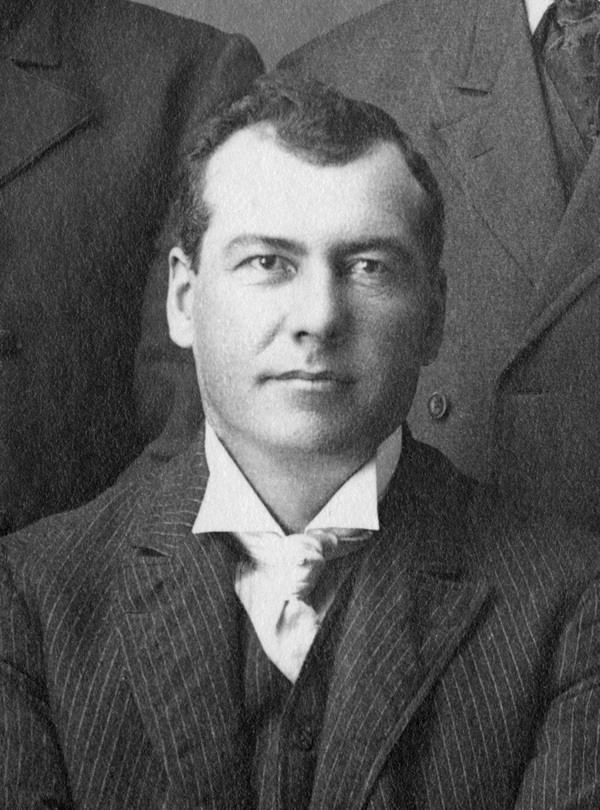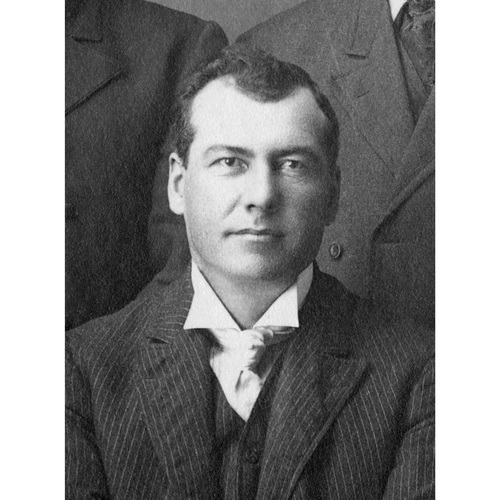
Source: Link
FIDLER, ALFRED DAVIS, railway employee, government official, and sportsman; b. 20 June 1869 in Brantford, Ont., fourth son of James Fidler and Margaret Davis; m. 3 Aug. 1898 Susan M. Spence in Howick Township, Ont., and they had three sons; d. 21 March 1927 in Calgary.
The Fidlers were a railway family who probably located first at Brantford when they arrived in Upper Canada in 1856. Brantford was an important railway town that became integrated into the national transportation system in the 1860s and 1870s when connections were made to the three main trunk lines: the Grand Trunk, the Great Western, and the Canada Southern. In 1871 Alfred Davis Fidler’s father, James, was working for the Grand Trunk as a fireman.
The 1881 census finds the Fidlers in St Thomas where the father and two eldest sons were railway workers. Later employment with the Canadian Pacific Railway took all of the family, except for Alfred’s sister, Mary, west. William, the second son, settled in Calgary in 1883; he was joined by his father and brothers Charles and Alfred in 1884. In 1888 the family moved to Canmore and in 1889 James, the youngest son, came with his mother. By 1891 John, the eldest, had arrived as well. Canmore was a division point and layover centre for CPR crews and Alfred was engaged in the running trades during the construction of the line; at the time of his marriage in 1898 he was a yardman. He would make an annual salary of $1,000 in 1901. In January 1899 the CPR moved its shops to Calgary and its division point to Lake Louise. Many of the railway’s employees relocated in Calgary over the next few years, including Alfred Fidler, now a freight conductor.
Fidler joined the government of Alberta’s Department of Public Works as a clerk on 29 March 1909, and in June that year he was appointed an inspector of local improvement districts. His experience with the CPR proved invaluable because of the connections between the railway and the department in bridge building and the shipping of construction materials for local projects. He became an auditor and inspector on 1 Jan. 1912 and then moved to the Department of Municipal Affairs, created that year, at an annual salary of $1,600. Fidler’s pay was increased to $1,800 in 1917 when he became inspector of munitions in the same department during World War I; he was appointed chief inspector in 1918 and made $2,400 annually from 1921 until his death.
One of the department’s functions was to administer the organization of municipalities and regulate their planning schemes; the inspector ensured that they followed proper procedures, oversaw the collection of local taxes, and audited the books to make certain they conformed to provincial regulations. It is recorded that Fidler audited the accounts of the municipal district of Cardston in 1922, for example. In July 1925 the secretary-treasurer embezzled funds from the Burlington municipal district, now in Forty Mile County. The municipality and the school districts faced financial ruin and were forced into trusteeship. The council was dissolved on 26 Oct. 1926 and the district was placed in charge of the official administrator, Alfred Fidler. After his untimely death, the deputy minister of the Department of Municipal Affairs, William David Spence, wrote that Fidler had been “employed in the service of the Department since its inception and organization and was engaged in the inspection of municipalities prior to that date as a member of the staff of the Department of Public Works. He was widely known and respected in his work, and had come to be recognized as an authority on municipal matters.”
According to his obituary, Alf Fidler was also known to many as “the Father of Baseball in Alberta.” This judgement appears to be the exaggeration of an old friend writing a eulogy for a local newspaper. Fidler’s family did come from a part of southwestern Ontario that was a hotbed for baseball in the late 19th century. Hamilton, Dundas, Woodstock, Ingersoll, London, and Guelph all had community-rooted professional baseball teams, strengthened by American “ringers” by the 1870s. These towns also hosted touring teams from the United States. Baseball was brought to the prairies by the early settlers from Ontario and the United States (Fidler was said to have been one of the first catchers to come to Alberta). In rural areas the game tended to be associated with activities on holidays, such as Dominion Day, Labour Day, and Victoria Day. The sport helped to build a sense of community in a new settlement and boosted the locality as well.
Fidler’s reputation as a ball player was probably the result of the fact that he played one season as a professional at first base for the Fort Worth Panthers in the Texas League, which was D level, in 1892. He was also a catcher, first baseman, and outfielder for teams in Medicine Hat, Canmore, and Calgary; in 1895 the Canmore team, which he had also organized, played only six games. In 1903 box scores in the Calgary Morning Albertan show Fidler on first base for the CPR team in the city amateur league. He also played for the Calgary team in a mid-summer tournament against other teams from southern Alberta. In 1906 he was the vice-president of an amateur baseball club in Calgary.
When the Western Canada League was formed in 1907 with professional teams in Edmonton, Calgary, Medicine Hat, and Lethbridge, Fidler was to join the Calgary Bronchos as a player but the scoresheets do not list him in the line-up. He was selected as the manager. The Albertan of 28 May 1907 reported that Fidler was to hit the ceremonial first pitch on opening day, but let his son Charles Alfred, known as “young Alf,” do it instead. He continued to play competitive amateur baseball in Calgary until he was 40, which earned him the nickname “Old Hoss.” For the rest of his life he umpired games throughout the province, including in the WCL.
Alf Fidler represented the tradition of “muscular Christianity,” in which manly sport was linked to the religious values – Fidler himself was an Anglican – that shaped the community. He was a gifted and respected athlete, remembered as “one of the squarest shooters in the game.” At the time of his death his home was 910 14th Avenue West in Calgary. He died of heart failure at the age of 57 on 21 March 1927, after cutting short a trip to Edmonton by train on government business the night previous. He was buried in Burnsland Cemetery in downtown Calgary, as was his wife after her death in 1954.
AO, RG 80-5-0-257, no.7323. Burnsland Cemetery (Calgary), A block, plot 31. LAC, RG 31, C1, St Thomas, Ont., 1881, dist.163, subdist.C, div.2: 67; dist.175, subdist.A, div.3: 27; 1891, 1901, Canmore, Alta; 1906, Calgary, dist.19, subdist.26: 10. Calgary Albertan, 22–23, 25 March 1927. Calgary Herald, 22, 25 March 1927; 13 Feb. 1954. Morning Albertan (Calgary), 15 May, 24 July 1903. Alta, Dept. of Municipal Affairs, Annual report (Edmonton), 1912–27; Treasury Dept., Public accounts of the province of Alberta (Edmonton), 1909–11. Alberta Assoc. of Municipal Districts and Counties, Story of rural municipal government in Alberta: 1909 to 1983 ([Edmonton, 1983?]). Alberta Geneal. Soc., Edmonton branch, Alberta: index to registration of births, marriages and deaths . . . (1v. to date, Edmonton, 1995–?), 1 (1870 to 1905). E. H. Appleby, Canmore: the story of an era (Canmore, Alta, 1975). N. B. Bouchier, For the love of the game: amateur sport in small-town Ontario, 1838–1895 (Montreal and Kingston, Ont., 2003). D. G. Burley, A particular condition in life: self-employment and social mobility in mid-Victorian Brantford, Ontario (Montreal and Kingston, 1994). Directory, Calgary, 1910–43. B. E.Ducey, The Rajah of Renfrew: the life and times of John E. Ducey, Edmonton’s “Mr. Baseball” (Edmonton, 1998). E. J. Hanson, Local government in Alberta ([Toronto, 1956]). Bill Kirwin, “A colony within a colony: the Western Canada Baseball League of 1912,” Nine: a Journal of Baseball Hist. and Social Policy Perspectives (Edmonton), 1995–96: 282–97. Lynne Marks, Revivals and roller rinks: religion, leisure, and identity in late-nineteenth-century small-town Ontario (Toronto, 1996). Jack Masson, Alberta’s local governments and their politics (Edmonton, 1985). Alan Metcalfe, Canada learns to play: the emergence of organized sport, 1807–1914 (Toronto, 1987). “Mike McCann’s minor league baseball page,” created by Mike McCann: www.geocities.com/big_bunko/ (consulted 18 Jan. 2004). Don Morrow, “Baseball,” in Don Morrow et al., A concise history of sport in Canada (Toronto, 1989), 109–39. M. K. Mott, “Manly sports and Manitobans: settlement days to World War One” (phd thesis, Queen’s Univ., Kingston, 1980). Ontario Geneal. Soc., Index to the 1871 census of Ontario, general ed. B. S. Elliott (30v., Toronto, 1986–92). “The southern Alberta pioneers and their descendants,” designed by James A. N. Mackie: www.pioneersalberta.org (consulted 18 Jan. 2004). L. St. G. Stubbs, Shoestring glory: a prairie history of semi-pro baseball (Winnipeg, 1996). Paul Voisey, Vulcan: the making of a prairie community (Toronto, 1987). D. G. Wetherell and Irene Kmet, Useful pleasures: the shaping of leisure in Alberta, 1896–1945 (Regina, 1990).
Cite This Article
David Mills, “FIDLER, ALFRED DAVIS,” in Dictionary of Canadian Biography, vol. 15, University of Toronto/Université Laval, 2003–, accessed December 31, 2025, https://www.biographi.ca/en/bio/fidler_alfred_davis_15E.html.
The citation above shows the format for footnotes and endnotes according to the Chicago manual of style (16th edition). Information to be used in other citation formats:
| Permalink: | https://www.biographi.ca/en/bio/fidler_alfred_davis_15E.html |
| Author of Article: | David Mills |
| Title of Article: | FIDLER, ALFRED DAVIS |
| Publication Name: | Dictionary of Canadian Biography, vol. 15 |
| Publisher: | University of Toronto/Université Laval |
| Year of publication: | 2005 |
| Year of revision: | 2005 |
| Access Date: | December 31, 2025 |



